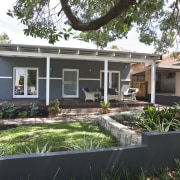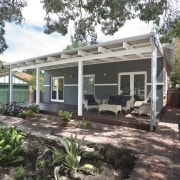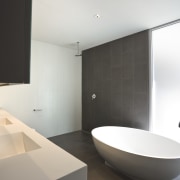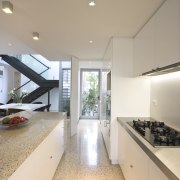Behind the scenes
Just as the Federation-style facade of this house belies a modern extension at the rear, so many of the sustainable-design features are not obvious at first sight
Sustainable design is just as much about creating a holistic lifestyle, as it is about protecting the environment. When both these elements come together, you can be sure a house ticks all the boxes for healthy, comfortable living.
Taking the sustainable design route was a priority for the owners of this Perth Federation-style cottage when they set out to renovate. But they also wanted to keep the heritage character of the existing house, says architect Rob Andary of Robert Andary Architecture.
"To this end we opened up the original front veranda, which had been enclosed. This creates a much greater interaction with the street the owners feel they are part of the local community."
The original front door was replaced with a wider, translucent glass door that allows light to flood the interior.
"Prior to the renovation, the house was very dark and quite run down," says Andary. "Providing an airy, light-filled living space was crucial it was just as important as the sustainable design."
Andary maintained the symmetry of the centred hallway that typifies Federation homes. Bedrooms and bathrooms are positioned on the left of the hallway, while a study and a new fully glazed stairwell are on the right side. The open-plan living area is contained within a large, contemporary extension beyond the stairs.
"The recessed, double-height glazing of the stairwell punctures the transition between the old and new," says the architect. "Providing a neutral colour for the compressed fibre cement extension also ensures the existing brickwork maintains its own identity."
The extension has been designed to maximise solar energy. A high thermal mass to the south, concrete flooring and optimal glazing to the north ensure a high thermal performance. A heavily insulated lightweight structure on the first floor also helps with thermal and sound insulation. As well, the light weight of the upper floor ensured the ground-floor living area could be a large, column-free space.
"Because the extension is four steps lower than the old part of the house, we were able to provide higher ceilings without affecting the overall height of the building, which is subject to restrictions," says Andary.
The extension was also designed to provide a seamless connection with the outdoors and a carport pavilion that can double as an alfresco dining area.
"From behind the kitchen bench, a visual connection between the east, west and north courtyards is established, highlighting the focal intersection between all the axes through the house," says Andary.
The double-height void has an extra role to play in achieving energy efficiency. The house is designed to cool itself naturally. Operable glass louvres draw in cool air, displacing the warm air through the high-level windows on the north.
"Each space is zoned for air movement and cross ventilation, with ceiling fans aiding the process," says Andary.
On an aesthetic level, the void also allows the owners to enjoy a view of a neighbouring park from the upper level. To provide a degree of privacy for upper bedrooms, a translucent glass wall was added to the top balcony.
Andary says the key circulation area of the original house is mimicked in the extension the main axis on the top floor is a continuation of the original spine, connected by the stairs.
"Wherever possible we used recycled materials," the architect says. "These include the jarrah treads on the stairs. We also re-used floorboards, brick pavers and limestone footings. Maintaining the original footprint of the house at the front was another conservation measure."
Other sustainable design features include energy-efficient lighting, photovoltaic cells to supplement the home's electricity use, solar water heating, a greywater recycling system and rainwater collection and storage for use inside.
Credit list
Builder
Cladding
Flooring
Sisal rug
Lighting
Lounge furniture
Dining table
Kitchen cabinets
Splashback
Cooktop, rangehood and dishwasher
Bathtub
Bath fittings
Greywater recycling system
Photovoltaic cells
Kitchen manufacturer
Paving
Fly screens
Bedroom carpet
Blinds
Heating and air conditioning
Dining chairs
Bar stools
Benchtops
Oven
Refrigerator
Basins
Bathroom flooring
Rainwater tanks
Story by: Colleen Hawkes
Photography by: Andrew Pritchard
Home kitchen bathroom commercial design
Classic looks, contemporary efficiency
Diving into nature
Personality plus
















